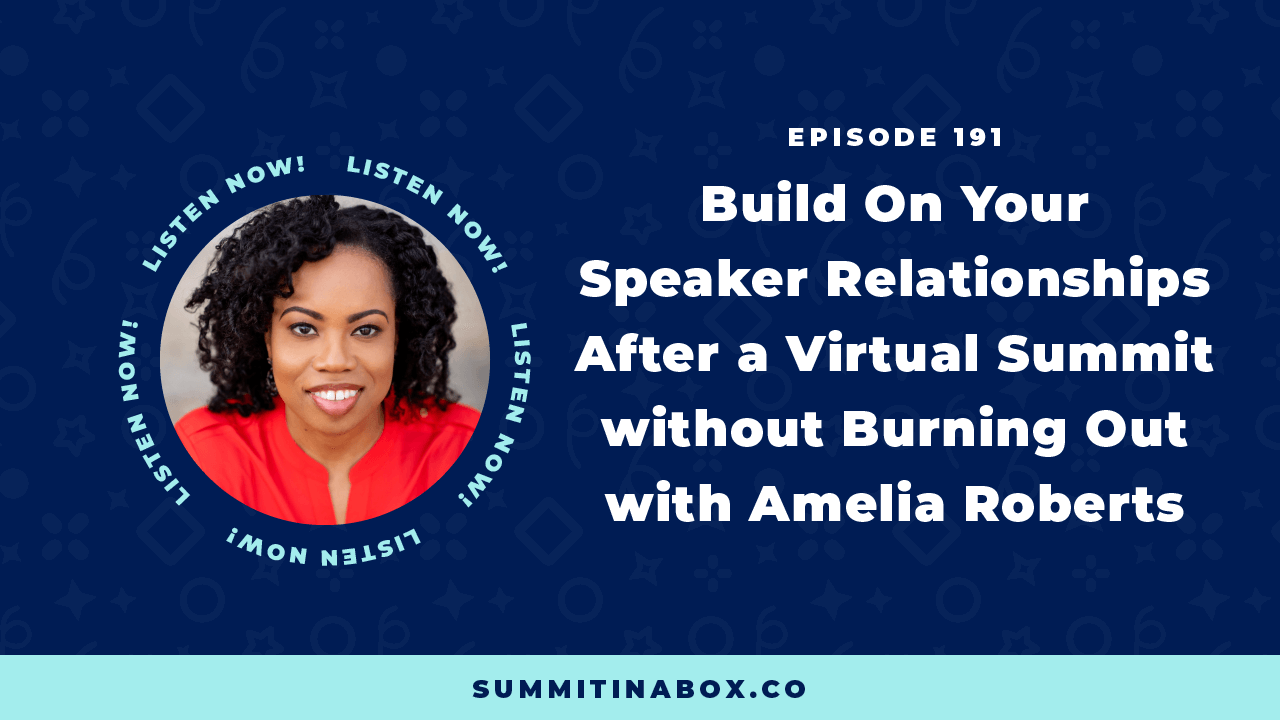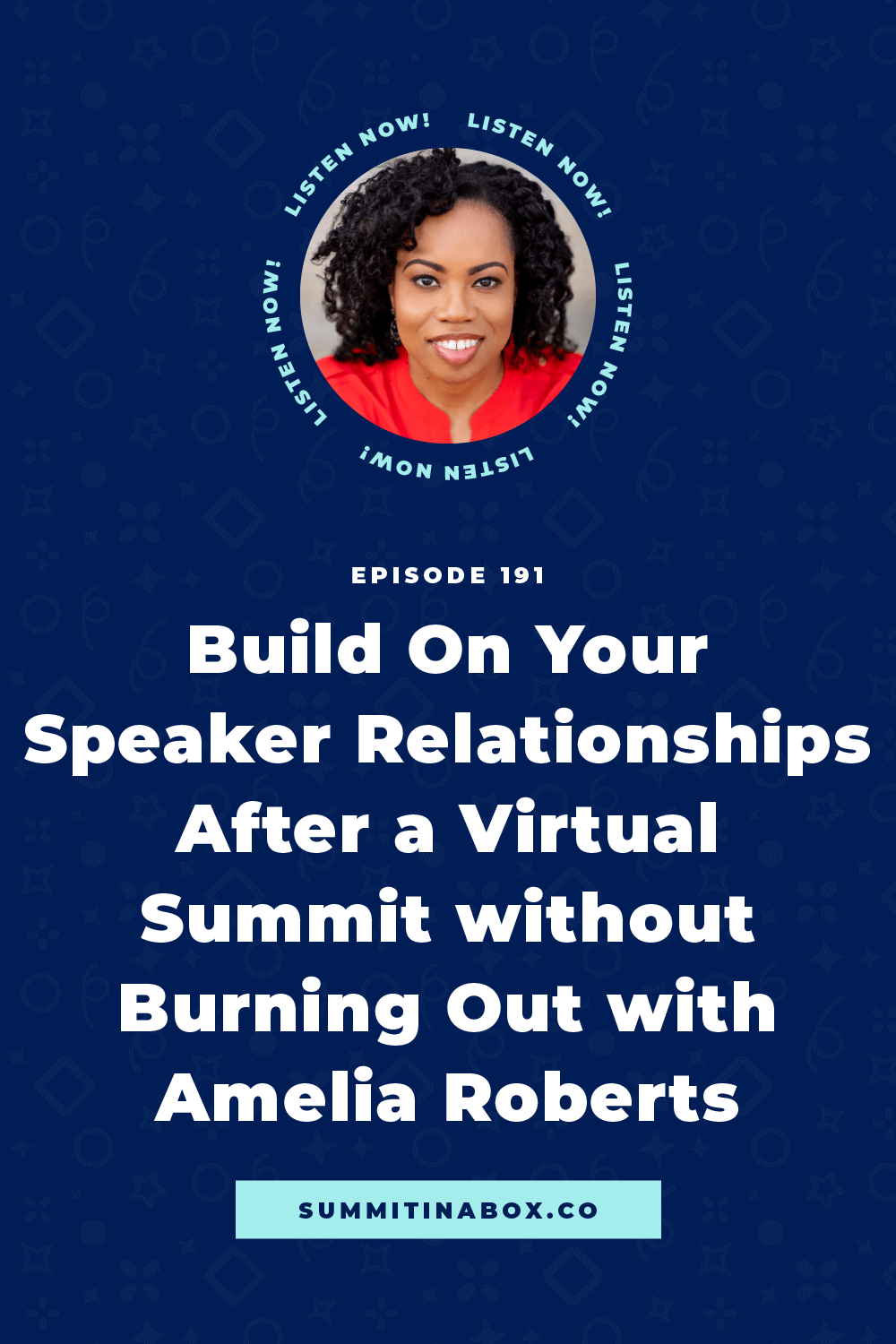Build On Your Speaker Relationships After a Virtual Summit without Burning Out with Amelia Roberts


Hosting a virtual summit is a powerful way to connect with peers that can lead to powerful collaborations, opportunities, and friendships down the road.
The connections you make with other business owners can be incredibly powerful and benefit your business in so many ways. Collaborating with 20+ experts in your industry by hosting a summit is an incredible way to quickly grow your network, but only if you make the most of those new connections!
If you're not intentional about it, it's easy to let those connections and relationships fade once the event is over and miss out on many of the opportunities that a summit can bring.
In this post, collaboration consultant Amelia Roberts is sharing how we can build on the relationships we have with our speakers in an organized way that won't zap all your energy.
If you value building your network in a sustainable way that doesn’t burn you out, you are going to LOVE these tips from Amelia.
I'll let her take it from here!
Relationship-Focused Social Media Marketing
I'm a registered nurse by trade, and got into social media marketing as a side hustle to pay off my student loans. As I started working with clients and getting deeper into the social media marketing world, I realized that I loved helping my clients with enrollment conversations and supporting them in building relationships that led to securing contracts.
I found that focusing on network building and relationships was a much more effective social media strategy for my clients than trying to make a post go viral.
I saw results happen when people had conversations and created relationships at scale, over any other form of marketing.
That’s what started this version of my business, from social media management to supporting teams by creating relationships at scale and having conversations that lead to revenue.
Using a Summit to Cultivate Conversations
What I love about Summit in a Box’s approach to summits is how it’s all about being specific with your audience and your summit’s topic. And that alone creates something to talk about with your speakers and with your audience.
By taking this approach, when you initially reach out to have those conversations, you're thinking about what a win-win-win would be.
- What would be a win for the other person?
- What would be a win for you?
- What would be a win for your shared audience?
When you deeply know who you serve, why you serve them, and why that matters, and combine that with a hyper-specific topic that your summit is about, you’ll be able to find a lot to talk about.
People who speak at summits tend to do other things too like JV webinars, podcasts, masterminds, bundles, etc. When you reach out to those connections and continue cultivating the relationship after a summit, beautiful things can come from that. There are so many opportunities to continue collaborating that can benefit you and your speakers.
When you’re intentional about keeping relationships going with your speakers and when you're cultivating these conversations, it can happen a little more naturally.
How to Keep Relationships Going
You work so hard to find amazing speakers, and connect with them to build a bit of a relationship before pitching. But if you're not intentional about it, it’s natural for those relationships to cool off after the summit for one reason or another. It makes sense to have a keep-in-touch system, so those relationships stay warm.
S.C.A.L.E. Your Relationships
I have a framework that I use that helps you to evaluate your capacity to implement a keep-in-touch program. Some people have the capacity to keep in touch because they have a team, they have the tech, or they have the personal capacity to do that. So this framework is called SCALE.
- Scan your ability to receive and to give.
- Create boundaries so you and your team know what a “no” looks like.
- Articulate value and know what your alignment looks like.
- Leverage resources that you have now.
- Evaluate whether this process has worked and if it served you.
When you use this process, you’re able to develop a creative eye for collaborations that benefit everyone involved. You and your team can see the ingredients of a great collaboration more easily and quickly. You’re also able to see the warning signs when things aren’t going well and make adjustments before it becomes an issue.
Your capacity to receive
In the first phase of the S.C.A.L.E. framework, when you scan your capacity, many people think this is about being an introvert or extrovert. But really, it's about your capacity to give and to receive. I'll give an example:
Some people, because of various life events that happen to them, have a very low capacity to receive. How this looks in real life is that they're in a room with somebody who has an amazing opportunity for them, and that person's ready to move forward, but they just clam up, say no, or self-sabotage.
So if your capacity to receive is low, that might also impact who you reach out to or who you think you’re deserving of collaborating with.
On the other hand, if you have a high capacity to receive, saying yes to these opportunities will feel a lot easier and more natural.
Your capacity to give
It's equally important to consider your capacity to give when considering the collaborations that make sense for you to pursue or say yes to. For example, if you have a team and systems and processes in places, then maybe you can have the capacity to agree to a higher-effort collaboration that requires 5 posts on Facebook, Instagram and LinkedIn, for example. If you don't have those things in place, or you're in a busy season where your capacity is lower, that might not be a good collaboration for you to agree to.
Your capacity for both receiving and giving are things you need aware of before starting a keep-in-touch system.
Keep In Touch
I am a fan of Trello for keeping up with my connections and following a plan for staying in touch. My Trello board is visually organized with a picture of a person in a dark alley, a picture of people talking, a picture of an engagement ring, and a picture of a wedding cake that symbolizes a commitment. These images represent the progression that a new connection goes through as you nurture your relationship with them. Consider how you might move somebody from a stranger to a commitment of some sort, whether that's agreeing to speak at your summit, or some other type of collaboration.
Keep in mind that some relationships warm up faster than others. Some will go from stranger to commitment quickly, and others will require more time. That's normal! The most important thing is to pay attention to your energy and move relationships forward at a pace that feels natural, without trying to rush it if it takes longer.
Maintain your Sense of Curiosity
The most important thing when trying to build relationships is to maintain your sense of curiosity.
For example, I’m an introvert, so when I speak at a summit or participate in collaborations where I have the opportunity to connect with a lot of people at once, I have to conserve my energy. Rather than trying to reach out and start conversations directly with everyone I met right away, I focus my energy on staying curious about what they're doing and what they're up to. I start to pay more attention to their emails or their social media posts so I have a better idea of who they are and what they're doing, which makes it easier to reach out when I'm ready.
The Seasonality of Connecting
One thing I see people getting wrong when trying to cultivate relationships is putting pressure on themselves to always reach out and make an outward effort right away after making a new connection. I believe in approaching connections seasonally. There might be a season when you need to recover from exerting a lot of outward energy and not have the capacity for a lot of outreach. There will also be other seasons where you're ready to reach out and connect with more people around you.
Avoid overwhelm. If you’re an introvert, block your time after something highly engaging so you have time to recover and don't put pressure on yourself to immediately reach out to every speaker you connected with. Keep track of who you want to connect with but give yourself the time and space to recover from your “forced peopling”.
When you come off a summit, you can be exhausted. The idea of keeping relationships with your 20+ speakers is a lot. Give yourself the time to recover first, and remember that it doesn’t have to be a constant thing. You can slowly reach out to a couple of people at a time.
Parts of that initial outreach can be outsourced too. For example, if your team knows you and what opportunities you’d be interested in, they can keep an eye out for those opportunities and bring them to you at regular weekly or monthly meetings.
Be Intentional
When you have a keep-in-touch system, it really can make that “peopling” more of a process versus random things that just show up in your calendar. Not to mention helping you conserve your energy and collaborate in a way that doesn't burn you out! This builds more intentional and personal relationships.
About Amelia
 Amelia is a digital native who has long enjoyed using tech and social media to spread useful information and connect friends with the resources they need to thrive in life, business and career.
Amelia is a digital native who has long enjoyed using tech and social media to spread useful information and connect friends with the resources they need to thrive in life, business and career.
She officially became a practitioner of online marketing several years ago with a role as a virtual assistant. One thing led to another and now alongside other hats, Amelia serves as a collaboration facilitator, word-of-mouth marketing advisor, and marketing accountability partner for high-achieving introverts, neurodivergent leaders, and customer-obsessed teams.
In short, Amelia went from using social media for cat videos to using these similar tools to empower individuals and teams to scale with sanity. When she is not equipping her clients to quickly build high-value relationships, Amelia enjoys planning real and imagined food tours.
Connect on LinkedIn | Follow on Instagram | Get In Front Of Anyone
Resources
- Episode 4: Discover Your Ideal Virtual Summit Audience
- Episode 5: Choose A Profitable Virtual Summit Topic
- Episode 43: How to Host a Virtual Summit as an Introvert
- Episode 188: Overwhelm is Optional: Resilient Time Management to Launch Your Virtual Summit with Stacy Brookman
- Summit Host Hangout Facebook group
Pin it for later!



5-Minute Virtual Summit Roadmap
The 5-Minute Summit Roadmap leads you through the 7 essential questions that will guide the rest of your summit planning process and help you finally start making meaningful progress toward a profitable event.

